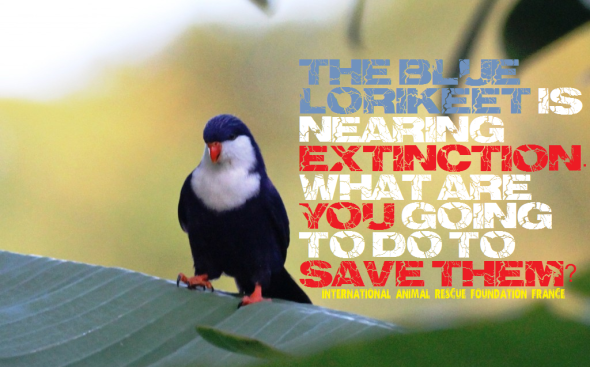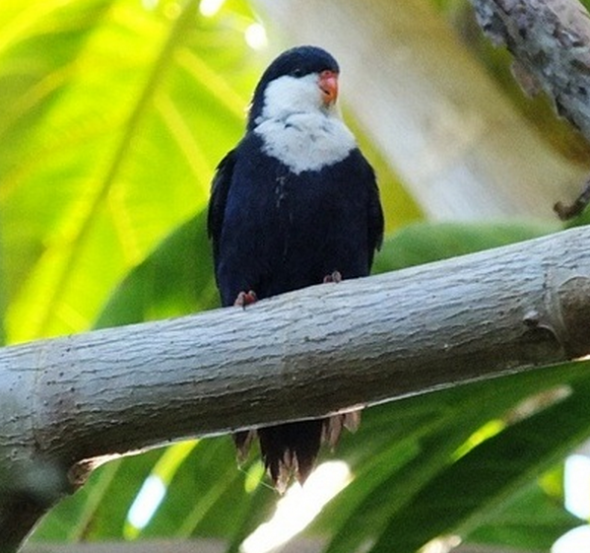Endangered Species Monday: Vini peruviana.
Endangered Species Monday: Vini peruviana
This Monday’s endangered species watch post (ESP) I document on a rather elusive bird that is rarely spoken about within the conservation theater or among animal rights organisations. Listed as (vulnerable) the species was formally identified by Professor Philipp Ludwig Statius Müller (April 25, 1725 – January 5, 1776) was a German zoologist. (Image V. peruviana, photographer Tara)
Statius Müller was born in Esens, and was a professor of natural science at Erlangen. Between 1773 and 1776, he published a German translation of Professor Linnaeus’s Natursystem. The supplement in 1776 contained the first scientific classification for a number of species, including the dugong, guanaco, potto, tricolored heron, umbrella cockatoo, red-vented cockatoo, and the enigmatic hoatzin. He was also an entomologist.
Despite the birds high population size the Blue Lorikeet-scientifically named as Vini peruviana is under threat from feral cats, accidental introduction of black rats and violent storms that hit the birds native range frequently causing untold damage and catastrophic destruction to the specie habitat. Furthermore the ‘swamp harrier’ remains an all out threat to Blue Lorikeet’s range which has led to wide range species decline. Swamp Harriers predate on the Blue Parikeet mainly due to the birds color.
Endemic to the Cook Islands and French Polynesia, Blue Lorikeet population sizes are declining quite fast of which drastic conservation measures are now required to control feral cats and the accidental introduction of black rats, not forgetting measures to either reduce swamp harriers or introduce a non-endangered prey for the harrier. The last survey which I believe was undertaken sometime back in 2012 showed a ‘global population’ estimated to be at 7,200 to 9,000 individuals. Which is still quite high, however not high enough to stop the species qualifying for the classification of (endangered).
Taking into consideration range and overall total population size (at an estimate) the species falls into the ‘band’ of 2,500 to 9,000 individuals. This equates (exactly) to 1,677-6,666 ‘mature individuals’ rounded to 1,500-7,000 mature individuals. Summarizing; the exact total population size could be as low as 1,500 but no greater than 7,000 mature individuals (which is extremely concerning).
Blue Lorikeet’s have been recorded within twenty of the south-east Polynesia islands, unfortunately on seven of these islands the species has since been declared officially extinct. The species now remains sparsely distributed on some thirteen islands of which is threatened by rats, feral cats and the swamp harrier. We now know the species is situated within the Society Islands (formerly all), the northern atolls of the Tuamotu Archipelago (both French Polynesia), and Aitutaki (Cook Islands).
Image: Blue Lorikeet - Vini peruviana
Within the Society Islands conservation teams estimated that there were some 200-400 individual pairs on the Motu One and Manuae respectively in 1973 , however this may no longer be the case. On the Maupihaa island back in 1999 conservationists that believed the species to be extinct located breeding pairs. In Tuamotus 2006 surveys have shown the following data in relation to population sizes; Kaukura (1,000), Rangiroa (1,000), Arutua (500), Apataki (200) and Tikehau (50).
Meanwhile in Tiamanu Motu in Apataki atoll a minimum 300 individuals were estimated back in 1989 (this sub-population being allegedly smaller than 10 years previously). On Aitutaki, where it was probably introduced, numbers have been estimated at under 500 pairs, 2,400 individuals and 1,000 individuals (2006).
Following the devastation of Cyclone Pat (2010) a further census was undertaken to asses the impacts of freak weather patterns and catastrophic cyclones on the species. Distance sampling surveys on the island of Aitutaki (2011) showed a decrease in population size of exactly 1,400 individuals. That’s quite a substantial decline of individuals caused directly by a single yet destructive cyclone.
Blue Lorikeets depend on coconut palms for nesting and some of its food, and will frequent cultivated areas. They also roost in palm trees, rising at dawn and calling and preening before feeding. They are usually found in small flocks of less than ten birds. They are active birds, feeding on nectar, insects, and ground forage.
Image: Swamp Harrier (Wiki) - . Circus approximans
Threats
The species’s extinction from many islands is most likely due to predation by black rat Rattus rattus and to a lesser extent, feral cats Felis catus. Blue Lorikeet’s have gone extinct from Makatea in the Tuamotus could have been accelerated by a particularly violent hurricane. Its range reduction in the Society Islands correlates with the spread of the introduced Swamp Harrier Circus approximans. The accidental introduction of black rats to the islands where Blue Loirkeet persists is a continuing threat to the species. Listed on Cites Appendix II conservation actions are under way with more projects proposed.
Thank you for reading.
Dr Jose. C. Depre
Botanical and Environmental Scientist.





